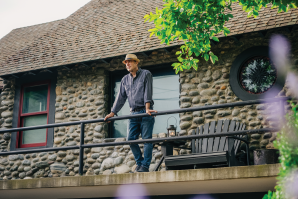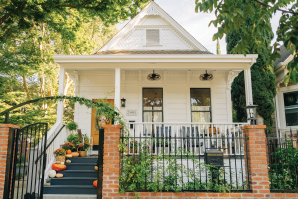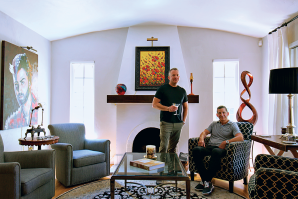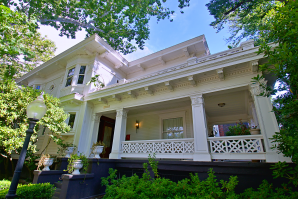As a child, Haley Wright often heard foreboding tales of an abandoned house in her hometown of Grass Valley. She vividly recalls the panic she felt the day she explored it for the first time, sitting on her father’s shoulders and walking up a dark, graffiti-covered staircase. Today, as general manager of North Star House, she muses, “If you would have told me I would end up working here, I would have cried. … Now I’m often here alone, and you can just feel all the love and the passion that has gone into this house.”
North Star House, designed by renowned 20th-century architect Julia Morgan and now owned by the nonprofit North Star Historic Conservancy, has for the last 20 years undergone the painstaking process of being restored to its original glory. The goal is for North Star House to serve as the area’s premier cultural center for the surrounding community, hosting events for all age groups, focusing on the arts, theater, history, literature and music.
A visitor on any Tuesday or Thursday will find the house humming with as many as 50 enthusiastic volunteers, some planning events, others giving tours and still others utilizing their skills in restoration, construction, gardening or historical research. Says Wright, “It really is special here — all the work they put into it. Everyone here cares so much.”
The original façade of Julia Morgan’s North Star House, shown
here, looks much the same today, thanks to the meticulous
restoration efforts of the North Star Historic Conservancy.
(Photo courtesy of North Star Historic Conservancy)

David Wright (no relation to Haley), board member and site architect for North Star House, is one of the longest serving volunteers. Two decades ago, as co-founder of the Nevada County Land Trust, he was asked to evaluate the dilapidated manse, overgrown with vegetation and surrounded by a tall fence. It had been ravaged by vandals, and the roof was nearing collapse; but, Wright remembers, “I could see it was once a pretty gracious place. It definitely looked impressive.”
Through research, Wright discovered a photo of the house in the book “Julia Morgan, Architect” by Sara Holmes Boutelle, confirming his impressions that the house was the creation of the esteemed architect.
In June of this year, North Star House received the honor of national significance from the National Register of Historic Places, a distinction awarded to only 1 percent of the country’s nominees. The home was recognized for significant contributions to U.S. history in the areas of architecture, literature, women’s history and equal rights. Moreover, only 2 percent of those receiving national recognition focus on women’s contributions, making this an exceptional honor.
In 1904, James Hague, owner of the thriving gold-mining operation North Star Mine, enlisted Morgan to design a house for his mine superintendent, Arthur De Wint Foote, and his wife, author and illustrator Mary Hallock Foote. Hague, inspired by the Bourn Cottage at the rival Empire Mine, envisioned a home that would reflect the wealth and status of the North Star Mine and serve as a social hub for entertaining local leaders and investors, in addition to serving as an elegant and comfortable family home.
The house was one of Morgan’s first significant commissions, as she had just become licensed that same year as the first female architect in California. Her talent was evident from the start, as her sophisticated design for the sprawling 11,000 square-foot Craftsman-style home has been praised as an outstanding exemplar of Morgan’s work. A proponent of the First Bay Tradition architectural style, Morgan incorporated local materials such as ponderosa pine, red cedar and quarried granite from the mine to integrate indoor and outdoor spaces and create harmony with the natural landscape. Morgan combined classical symmetry with rustic simplicity, albeit on a grand scale, employing stone terraces, pillars and cedar shingles to provide both a grounding and a welcoming sense of place.
The original fireplace in the living room was destroyed by
vandals searching for gold behind the bricks. The replacement
bricks were procured from the original manufacturer, Gladding
McBean, a renowned terra cotta tile company which has been doing
business in Lincoln for 150 years.

With Hague’s request for a multipurpose home, Morgan hit the mark. She was unique in her ability to design multifunctional rooms which provided intimate settings to gather within a grand space. This feature was a hallmark of North Star House and is recognized as the prototype for Morgan’s future buildings. Morgan would go on to create over 700 buildings, among them the YWCA Asilomar Conference Grounds in Monterey and the famed Hearst Castle in San Simeon. In 2014, she was the first woman to be honored (posthumously) with a prestigious gold medal by the American Institute of Architects.
The original residents of North Star House were illustrious, as well. Mary Hallock Foote, a college-educated career woman and early feminist, was a master woodcut book illustrator and a sought-after artist for such literary titans as Nathaniel Hawthorne, Henry Wadsworth Longfellow and Louisa May Alcott. Later, she transitioned to writing novels from the vantage point of a sophisticated East Coast woman navigating life in the rustic, gold-mining American West. Her strong female characters were on equal footing with the men, and her books, in the progressive era of the early 20th century, were highly acclaimed.
The Heritage Garden at North Star House showcases many species
that were originally planted on the property, including
hydrangeas, viburnum, boxwood, roses, Shasta daisies and
sunflowers. Grapes, pear and pineapple guava trees were donated
by the Felix Gillet Institute.

Although Hallock Foote was already nationally distinguished when
she and her husband moved into North Star House in 1905, a
significant body of her work was written while living at the
house, with her books increasingly focused on issues of women’s
rights. (Remarkably, Julia Morgan designated the house’s office
for Hallock Foote – an uncommon gesture at the time and an
acknowledgement by Morgan of changing gender roles, of which she
herself was a prime example.)
In 1919, Hallock Foote wrote “The Ground-Swell,” possibly the
first mainstream American novel to feature a lesbian
relationship. Hallock Foote’s beloved granddaughter was openly
lesbian, and this was likely a motivation for her emphasis on the
subject of the so-called “third sex.”
Mine superintendent, A.D. Foote, despite his occasional financial struggles, was a brilliant engineer, inventor, horticulturist and photographer. In addition to engineering the world’s largest Pelton wheel at the time (a hydroelectric turbine used in mining), Foote developed and traded new plant cultivars with two other horticultural pioneers, Luther Burbank and Felix Gillet.
Foote planted Edwardian-style gardens on the surrounding acreage at North Star House and documented his work through photographs and plant lists. Carole Miller, an early volunteer with the conservancy, identified original landscape plantings by using Foote’s records, exploring the property and interviewing descendants. (The home remained in the Foote family until 1968.)
Many of the original plants, however, were lost due to neglect and grazing deer. As a tribute to Foote’s original landscape, the conservancy created the charming and colorful Heritage Garden: a large, fenced plot that includes many of the original cultivars. A variety of other thoughtfully planned projects are ongoing.
North Star House’s dedicated volunteers gather in the living
room. Back row: Rich Hill (board member), Jeff Cerrighino (board
member), Larry Joseph, Gary Emanuel, Don Bartlett, Richard Panos
(board member), Jim Borrelli, Rebekah Freeman, Kenneth Underwood,
Tom Milam and Tony Favro. Front row: Jennifer McGuire (house
manager), Wyn Spiller (board member), David Wright (site
architect/board member) and Haley Wright (general manager).

The quality shines through every facet of North Star House’s restoration. The first floor has been completed (again with the help of Foote’s photographs) with the utmost attention to detail and serves as a pristine snapshot in time. Efforts on the second floor are just getting started. In keeping with the conservancy’s mission, plans for the upstairs include classrooms, workshops for arts and crafts, and the Margaret Swan Levine Art Gallery, named in honor of a revered local leader, artist and early champion of North Star House.
Such a monumental endeavor is, of course, dependent on funding. The conservancy recently launched a fundraising campaign for its most pressing need: a fire sprinkler system to protect the house. Events at the venue also provide income. Last year, North Star House hosted 35 weddings on the picturesque grounds, with all profits going to the restoration effort. House Manager Jennifer McGuire explains to couples “that they are not just renting a venue, they are actually contributing to the restoration of the house.” Most relish the opportunity to play a role in this effort, she says, preserving a connection to history, architecture, literature and the ideals that formed a national heritage.
Walk-in visitors are welcome to view the house and grounds and meet the dedicated volunteers on any Tuesday or Thursday. Free guided tours with a resident historian are offered every second and fourth Thursday of the month, from 1-3 p.m. No reservation is necessary. For an ideal day trip, add a visit to the nearby North Star Mining Museum and Empire Mine State Historic Park, then have dinner in the quaint, historic downtown Grass Valley.
Comstock’s “Unlisted” is an insider’s look at noteworthy homes that aren’t for sale. To recommend a house to be featured, contact dmorlan@comstocksmag.com.
–
Stay up to date on business in the Capital Region: Subscribe to the Comstock’s newsletter today.
Recommended For You

The California Modernist Dream Is Alive in Sacramento’s Newest Historic District
Step inside an emblematic Midcentury home in South Land Park, designed with a social conscience
The interior retains many of its original “Eichler” features, including pristine globe light fixtures and mahogany-paneled walls.

This Fanciful Retreat Turns Heads With Soundscapes and Water Features
Visionary voice actor transformed a derelict bungalow into his own ‘happiest place on earth’
Du Bose, a voice actor, lived in L.A. for 25 years before growing weary of the scene. In 2015 he resettled in his hometown of Fair Oaks while continuing to work in the industry. To decompress from a stressful job, Du Bose threw himself into transforming his yard and home into a showstopper. “I wanted to make it feel like I was on vacation,” he says.

Architect’s NorCal ‘Dream Home’ Embraces the Mediterranean Climate
The high-tech house in the hills is a playground for entertaining, car collecting and relaxation
“It’s a pretty spectacular home that emulates the juxtaposition of modern and traditional design in a Northern California style,” Brian Whitmore describes his house located in the Sierra de Montserrat development in Loomis.

This Midtown Jewel Box Was a Diamond in the Rough
The condemned Victorian sat vacant until a visionary couple took notice
For years, Mike Baddley walked his dog from his J Street office past a dilapidated little house on the corner of 24th and I Streets in Midtown. “I was fascinated with it,” he says. The abandoned folk Victorian-style house, built in 1893 for H.L. Cuthirth, had been deemed by the city a substandard building, meaning not safe for occupancy.

This Parkside Cottage Is Depression-Era Perfection
Owners Tom Gaudio and Rob Eastwood meticulously blend antique with chic in their eclectic forever home
They are the fourth owners but the first to make major renovations. The property has been updated to the highest standard, from the front yard, designed and planted by Eastwood, to the sophisticated, art-filled interior, and through to the jewel box of a backyard complete with a saltwater pool of their own design.

This Lovingly Restored House in Boulevard Park Is a Home for Big Ideas
Owner Robert Watson believes synergy is key in repairing historic architecture
Take a peek inside one of Midtown’s best-preserved early-20th century beauties (that’s not for sale).



